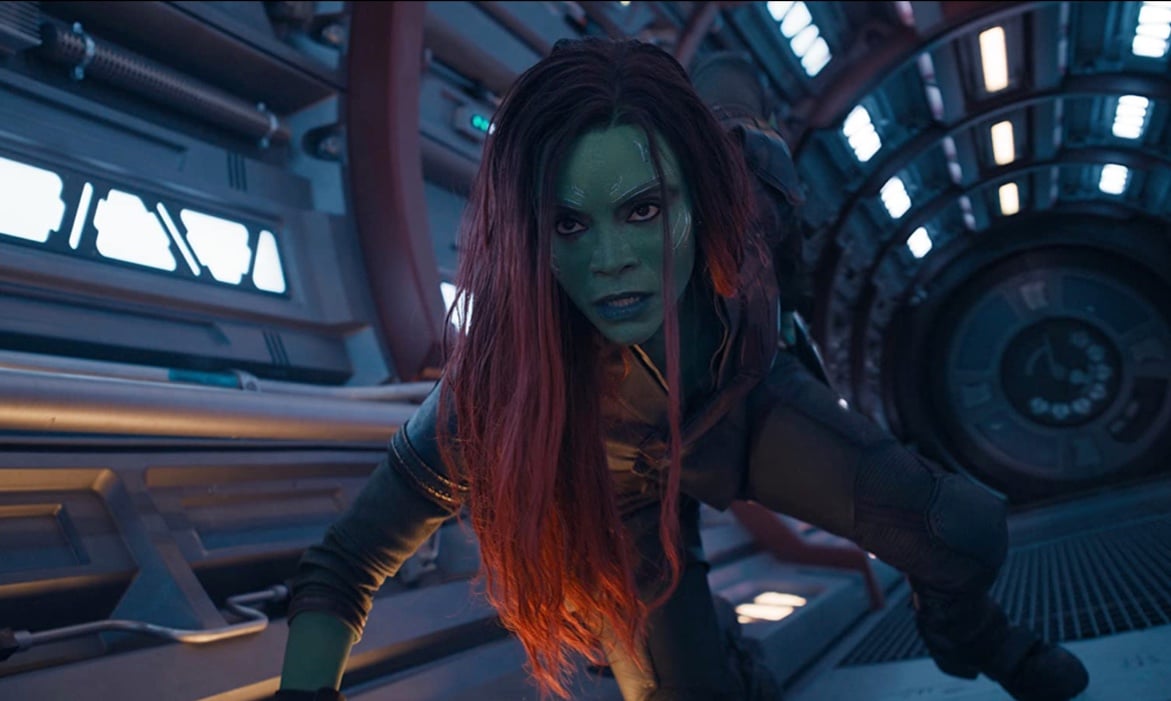 Zoe Saldana in Guardians of the Galaxy Vol. 3 (Marvel Studios)
Zoe Saldana in Guardians of the Galaxy Vol. 3 (Marvel Studios)The opinion that Marvel Studios had lost its groove or been off its game since the conclusion of the Avengers-Thanos Saga with “Avengers: Endgame” in 2019 has not only been a popular but also the prevailing thought about the films in recent months among hard-core fans. And the box office backs that up.
Movies like “Shang Chi and the Legend of the 10 Rings” and “Spider-Man: No Way Home” are exceptions, but the other Marvel products both on the big and small screen had been deemed lackluster of late, especially the recent “Ant-Man and the Wasp: Quantumania,” which failed to reach the $475 million mark, which is a low cumulative for a film which was planned to kick-off the next big Marvel storyline.
The fact that an alleged paramour-abuse scandal now surrounds Jonathan Majors, the movie’s villainous co-star, is another hurdle. Marvel has re-cast before, but not in such a prominent role.
While Marvel’s movie franchise remains the of most popular and profitable cinematic franchise of all time, the chinks in the armor are beginning to show.
While I’m not sure one movie is proof that the MCU is back headed in the right direction, director James Gunn’s Marvel swan song “Guardians of the Galaxy Vol. 3” is without a doubt my favorite Marvel Movie since “Avengers: Endgame” in 2018.
Why is this film Gunn’s Marvel swan song? Once publicity for this film is over, he crosses the street to fully commit his time to running DC Studios with Peter Safran. He has already completed the script for “Superman Legacy,” which he will produce and direct. The film is in pre-production for a July 11, 2025 launch.
But back to Marvel.
Certainly opinions vary, but this film runs our group of space vagabonds through an emotional and action-packed wringer as the Guardians work to save their “raccoon-like” buddy Rocket and bring the cruel machinations of the evil entity known as the High Evolutionary (Chukwudi Iwuji) to an end. It’s not going too far or giving away too much to say the Guardians will never be the same after this movie.
The High Evolutionary, based on novelist H.G. Wells’ vivisectionist mad scientist Dr. Moreau from his 1896 sci-fi classic “The Island of Dr. Moreau,” is a supremely powerful entity that some corners of the universe worship as a god, according to the movie’s exposition. He and his corporation Orogscope conduct cruel experimentations on animal lifeforms from around the universe to create humanoid-animal crossbreeds. When such creatures aren’t deemed perfect, the High Evolutionary enjoys cleaning the slate even if that means genocide and starting all over again.
When the Guardians learn that Rocket (voiced by Bradley Cooper) is one of the villain’s surviving experiments, and that High Evolutionary holds the key to saving their little buddy’s life, the team springs into action to infiltrate the Orogosphere in order to find the information they need to save their cybernetic friend.
During the film we learn Rocket’s origin and of the abuse he survived and the friends he lost along the way in flashbacks to the High Evolutionary’s nefarious actions. While I would opine some early reports of depictions of animal cruelty might be exaggerated, such material affects everyone differently. Aspects of Rocket’s backstory are sad and brutal, but also sweet and tender.
Once the Guardians discover that the High Evolutionary has hundreds of hybrid children imprisoned on his ship, the group put their lives on the line to rescue them.
Ultimately the movie is about changing relationships. This is seen with all the characters but is most evident with Star-Lord Peter Quill (Chris Pratt) and Gamora (Zoe Saldana). If you remember, Thanos sacrificed his daughter Gamora in an effort to gain one of the Infinity Stones in an earlier movie; however, a Gamora from the past came forward to the present, and that is the Gamora in this movie.
 Will Poulter and Elizabeth Debicki in Guardians of the Galaxy Vol. 3 (Marvel Studios)
Will Poulter and Elizabeth Debicki in Guardians of the Galaxy Vol. 3 (Marvel Studios)The time-shifted Gamora was from a very different time and place and had not experienced falling in love with Quill. While very similar physically, she was not in the same headspace emotionally or intellectually, leaving Quill virtually lost. Saldana and Pratt do an exceptional job emoting this storyline, which isn’t the overarching plot of the film but is certainly at its emotional crux.
Likewise Dave Bautista as Drax, Pom Klementieef as Mantis, and Karen Gillan as Nebula each have satisfying emotional arcs that leave their characters matured by the end of the film. The chemistry between all the actor is extraordinary.
Groot (voiced by Vin Diesel) gets several key moments of action in the movie, and his “I Am Groot” continues to work as a fun tag line all these years later. Nathan Filllion (“The Rookie,” “Castle,” “Firefly”) has a funny extended cameo. Will Poulter plays Adam Warlock, a fan-favorite Marvel character, that seems a bit wasted in the context of the film, but maybe there are future plans for the character?
The film is a treat under Gunn’s direction with a ton of eye candy. The alien aspects of the film truly appear alien, and while the movie is a two-and-a-half-hour opus, it never feels long.
There is a two- or three-minute, slow-motion action sequence near the climax of the film that is superlative. It feels like it was ripped right out of the centerfold of a comic book.
Gunn again fills the film with a musical playlist of tunes that only accentuate the emotion and action being depicted on screen.
I don’t know exactly where I would rate “Guardians of the Galaxy Vol. 3” among the entirety of Marvel’s films or even really within Gunn’s “Guardians Trilogy” at the moment. It certainly fits in the upper fourth of Marvel films to me, and is a strong conclusion to Gunn’s chapter of Guardians films.
The movie has two closing credit scenes that certainly give hints where the Guardians franchise and some of its characters might be headed.
(PG-13) 2 hr. 30 min.
Grade: B+
New in Local Theaters – May 5, 2023
• Guardians of the Galaxy Vol. 3 (PG-13) 2 hr. 30 min. (trailer)(AMC Fiesta Square, Malco Razorback, Malco Springdale Malco Towne, Malco Pinnacle, Skylight)
• Love Again (PG-13) 1 hr. 44 min. (trailer)(AMC Fiesta Square, Malco Razorback, Malco Springdale, Malco Towne)
Classic Corner – Borrowing from the Best
 Barbara Carrera and Michael York in The Island of Dr. Moreau (1977) (Metro-Goldwyn-Mayer)
Barbara Carrera and Michael York in The Island of Dr. Moreau (1977) (Metro-Goldwyn-Mayer)In many ways, the production of comic books from the late 1930s through the 1970s was a “hack” business.
Not to say the artists and writers weren’t extremely inventive and talented. Many absolutely were.
However, they were asked to churn out so much material so quickly that shortcuts were often and obviously taken.
Even the greats of the industry borrowed liberally from literature and the cinema in order to concoct the continuing adventures of their characters. That includes the fathers of the Marvel Universe Stan Lee and Jack Kirby.
A great example is new in theater this week in director James Gunn’s latest and final film for Marvel, “Guardians of the Galaxy Vol. 3.”
The movie’s key antagonist is a being known as the High Evolutionary (Chukwudi Iwuji), whom Kirby and Lee modeled after the classic H.G. Wells’ villain Dr. Moreau from his 1896 novel “The Island of Dr. Moreau. Moreau was a mad vivisectionist who enjoyed using surgery to mix humans and animals into strange creatures whom he forced to worship him as a god through torture and brainwashing.
I thought it would be fun to look back at three film adaptations of Wells’ nightmarish novel since his ideas are being celebrated on the big screen with Gunn’s latest Guardians adventure.
The Island of Lost Souls
Released by Paramount in 1932, “The Island of Lost Souls” was a follow-up to the studio’s highly successful 1931 horror movie “Dr. Jekyll and Mr. Hyde.”
While very dated for a modern audience, the films stand out as two of the best-made and truly creepy and disturbing horror movies of the era.
Certainly Universal’s “Dracula” and “Frankenstein” from 1931 stand as more popular, but along with 1932’s “Freaks,” I’d consider “Dr. Jekyll and Mr. Hyde” and “The Island of Lost Souls” as the most horrific films of the pre-code, early talkie period.
The movie was deemed highly controversial from the start and was banned in Great Britain, Germany, New Zealand, Italy, and India for the subject matter. Dr. Moreau, devilishly played by Charles Laughton, had made an island full of man-beast creatures, but now he planned to mate Lota, the Panther Woman, (Kathleen Burke) with stranded traveler Edward Parker (Richard Arlen).
Bela Lugosi, less than a year after playing Dracula and already bankrupt, portrays the Sayer of the Law, a half-man, half-beast leader of the creatures Moreau created. Think of him a monstrous jail trustee. Rumors are that young actors Alan Ladd, Randolph Scott, and Buster Crabb (Flash Gordon) were made up as beast-men extras in the film, well before they became famous.
There were many cuts of the movie with excised dialogue and scenes to make the film more palatable. The most complete cut of the original film is available from Criterion on DVD/Blu Ray.
Island of Dr. Moreau (1977)
While my favorite of these three films is “Island of Lost Souls,” the most watchable for a modern audience might be the 1977 version, starring Burt Lancaster as Moreau and Michael York as ship engineer Andrew Braddock, whom Moreau wants to mate with the lovely Maria, portrayed Barbara Carrera.
The creature costumes for the “Humanimals” will remind you a bit of the make-up effects from the Planet of the Apes films. The creep factor is present in this version, but it’s not quite as jarring in my mind to “Island of Lost Souls.”
Island of Dr. Moreau (1996)
While this version might sound interesting because of its cast with Marlon Brando as Moreau, Val Kilmer as Moreau’s enforcer, Dr. Montgomery; and David Thewlis as the intended mate of panther-girl Aissa (Fairuzza Balk), it is a mess of a movie that was troubled from the beginning by Brando’s eccentricities, which Kilmer found so hilarious that he reportedly began to mimic himself while on set.
Richard Stanley, who co-wrote the screenplay with Ron Hutchinson, was removed as director midway through the shooting with John Frankenheimer (“The Manchurian candidate,” “Seven Days in May,” and “Black Sunday”) brought in to finish the movie.
All that disfunction shows up in the product, which was a box office bomb and is really only watchable as a Mystery Science Theater-like laugh-fest.

